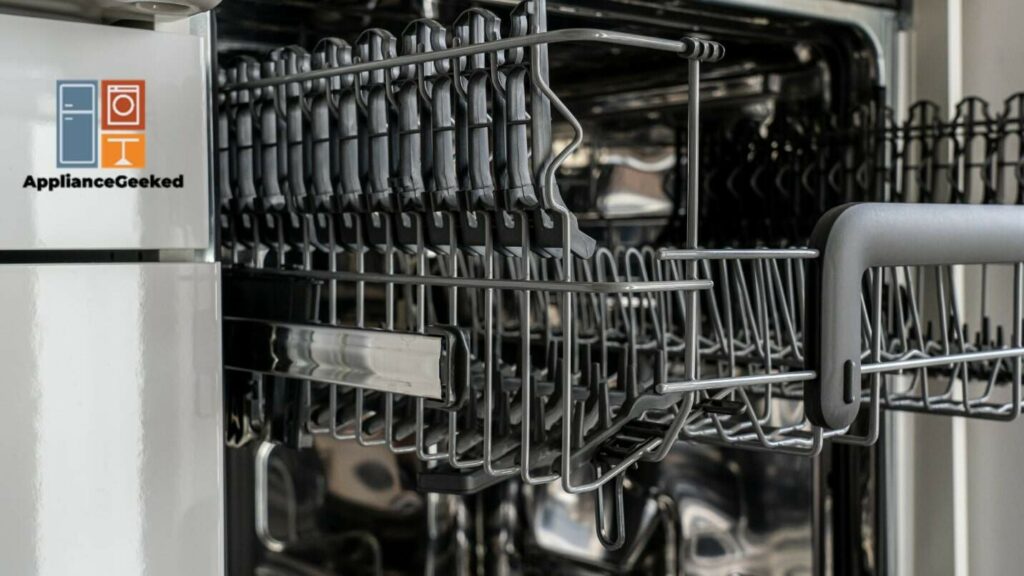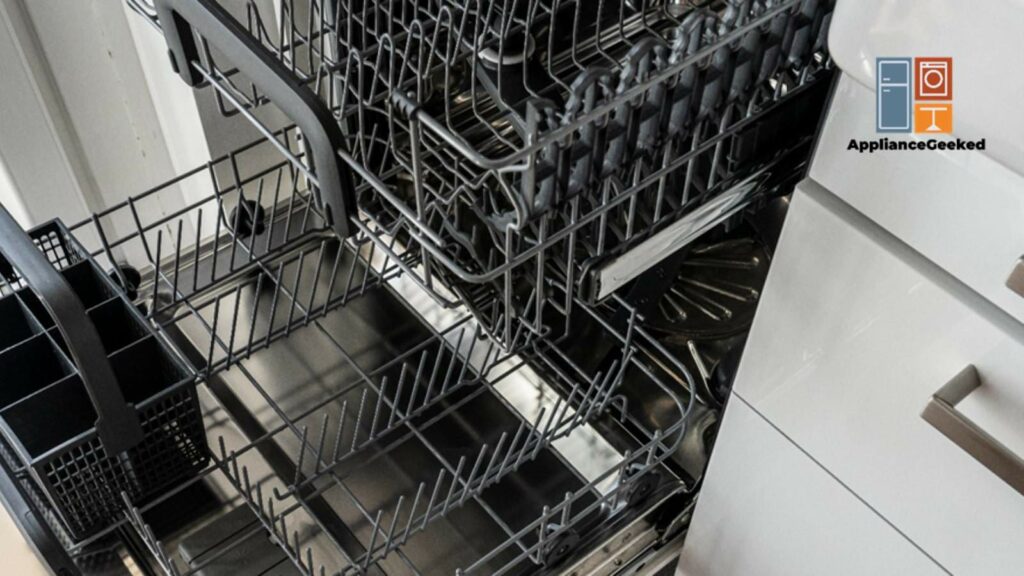
A Bosch dishwasher is worth the investment—although not a cheap one. You might start to think otherwise when you encounter drying problems, but we’ll help you get through them.
If you end up wiping your dishes after cycles, there are a few quick fixes that you can do to resolve the problem. Adding Rinse Aid, changing the settings, and loading the dishes properly are some of them.
Here, we’ll walk you through different solutions and show you a few tips to prevent drying issues from recurring.
Why is my Bosch dishwasher not drying?
If your Bosch dishwasher isn’t drying, it’s most likely caused by overcrowding. Adding too many plates will restrict the circulation of hot air, leaving your dishes with wet spots.
Your dishwasher’s poor drying performance can also be the result of incorrect settings or a lack of Rinse Aid.
Most modern Bosch dishwashers use a condensation process to dry the dishes, while older models use a heating element.
If you have the latter, a faulty heating element can prevent your dishwasher from drying properly. A replacement is necessary to get your unit back in optimal condition, which is a cheaper alternative to buying a new model.
However, a modern Bosch dishwasher has advanced drying capabilities that are worth investing in. Compared to models that use heating elements, newer iterations are more hygienic and energy-efficient.
How to Fix a Bosch Dishwasher That Won’t Dry
Fixing a Bosch dishwasher’s poor drying performance can be as simple as changing the settings, adding the right amount of Rinse Aid, and loading the dishes properly.
If only hard-to-dry plastic items are coming out damp, use the Extra Dry setting or change your Rinse Aid.
Below, we made a list of the most common causes of a Bosch dishwasher’s poor drying performance. We also offer step-by-step instructions to help you troubleshoot the issue by yourself.
| Causes | Solutions |
| Pre-washing Dishes | • Scrape the food scraps off the plates and into the bin before loading them into your dishwasher. • Load the plates and the silverware into the unit without overcrowding. |
| Overcrowding | • Load the dishes into the dishwasher on the correct rack. • Place small plates, bowls, glasses, and cups on the top rack of the dishwasher. • Keep them upside down and tilted to an angle. • Load large bowls, serving plates, and other dinnerware on the bottom rack. • Dishes must face inward while larger bowls stay upside down to promote better airflow. • Add a single item to each compartment in the silverware basket, alternating between spoons, forks, and knives. |
| Incorrect Settings | • Turn on your Bosch dishwasher. • Select AutoAir or Crystal Dry. • Select the Sanitize and Extra Dry settings if available. • Press Start. |
| Not Enough Rinse Aid | • Open the Rinse Aid dispenser. • Pour Rinse Aid until it reaches the max line. Do not overfill the dispenser. • Close the lid until it snaps into place. Then, clean any excess product around the dispenser. |
Pre-Washing Dishes
Did you know that pre-washing or rinsing dishes isn’t necessary?
Modern Bosch dishwashers use a condensation process for drying. Instead of a heating element, these new models use the residual heat from the final rinse to dry the dishes.
Since your dishwasher has a stainless steel tub, it will cool faster than its load. When moist air comes into contact with the cool tub, they turn into droplets and slide off the dishes, especially with the help of Rinse Aid.
Solutions: Scrape the food scraps off the plates and into the bin before loading them into your dishwasher. Load the plates, bowls, and silverware into the unit without overcrowding.
Overcrowding
Overcrowding is one of the most common causes of drying issues in a Bosch dishwasher.
If you load dishes in the wrong racks, or you add too much inside, hot air won’t circulate properly, preventing your dishes from fully drying. It also extends the duration of the drying cycle.
Fortunately, it’s easy to resolve and prevent. As long as you load the dishes correctly, you won’t have to manually wipe them after each cycle.
Solution: Empty your Bosh dishwasher, starting from the bottom rack to keep the dishes at the top dry. Load your dishes in the right rack and run a new cycle with the appropriate settings.
- Top Rack: Arrange small plates, bowls, glasses, and cups on the top rack of the dishwasher. Keep them upside down and tilted to an angle.
- Bottom Rack: Add large bowls, serving plates, and other dinnerware on the bottom rack. Make sure dishes face inward while larger bowls stay upside down to promote better airflow.
- Silverware Basket: Only place a single item in each compartment, alternating between spoons, forks, and knives. Load spoons and forks with the handles down while knives should be loaded with the sharp edges down.
| Tips: • It’s safe to add plasticware on the bottom rack if your Bosch dishwasher has no heating element. • After cycles, start unloading the dishes from the bottom rack to prevent the top rack from dripping everywhere. |
Incorrect Settings
Your drying problem might just be the result of incorrect settings. For instance, the Rinse and Hold program rinses your dishes, but it won’t clean or dry them.
Getting to know the different functions of your Bosch dishwasher will help you better understand the settings and their effect on your dishes.
Take note that these programs may vary per model. We recommend reviewing your user manual because it has more detailed information about your specific unit.
Here are some of the drying capabilities of Bosch dishwashers.
- PureDry is the standard drying technology on all modern Bosch dishwashers. It is a closed-drying process that whisks moisture away without using outside air.
- AutoAir automatically opens the dishwasher door towards the end of the drying cycle to pull in fresh air to dry your dishes.
- Crystal Dry is the most advanced drying technology available on 800 and 800 premium Bosch dishwashers. It transforms moisture into heat to maximize drying, especially for hard-to-dry plastics.
Solution: To select a drying program for a Bosch dishwasher, follow these steps:
- Step 1: Turn on your Bosch dishwasher.
- Step 2: Select AutoAir or Crystal Dry.
- Step 3: Select the Sanitize and Extra Dry options if available.
- Step 4: Press Start. Then, wait for the cycle to finish.
| Quick Note: • Only select models have an Extra Dry function that promotes better drying by adding extra heat to the final rinse cycle. • Similarly, the Sanitize function increases the time and temperature of the final rinse cycle to boost the drying performance. |
Not Enough Rinse Aid
Rinse Aid lowers the surface tension of water, allowing it to slide off easily. It not only makes your dishes sparkle, but it ensures that they dry properly every time.
Bosch recommends using the Finish Jet-Dry Rinse Aid for regular loads and the Turbo-Dry for plasticware. However, you can opt to use other labels.
Typically, plasticware and Teflon dishes are difficult to dry. Adding Rinse Aid, as well as using the Extra Dry setting, will boost the drying performance of your dishwasher.
Solution: To add Rinse Aid to your Bosch dishwasher, follow these steps:
- Step 1: Open the washer door.
- Step 2: Press the latch on the Rinse Aid dispenser and pull the lid to open it.
- Step 3: Pour Rinse Aid until it reaches the max line. Do not overfill the dispenser.
- Step 4: Close the lid until it snaps into place.
- Step 5: Wipe away any excess product around the dispenser to avoid excess foam from forming.
- Step 6: Run the dishwasher.
| Tips: • Pour from the side of the compartment to prevent spills. • Water stains on the utensils may indicate that not enough Rinse Aid was added to the dishwasher. • Rainbow stains are a sign that too much Rinse Aid was added. • Bosch doesn’t recommend homemade Rinse Aid as it may damage the dishwasher and invalidate your warranty. |
Frequently Asked Questions
You can fix your Bosch dishwasher’s poor drying performance by yourself. It rarely requires professional service as it’s commonly caused by a minor issue, which can be resolved in a few minutes.
If you don’t pour Rinse Aid into your dishwasher, your dishes will still dry from the residual heat of the cycle. However, you might notice a decrease in drying performance, especially when it comes to hard-to-dry plasticware.
Rinse Aid is a drying agent that will help your dishes dry faster. Without it, you might notice some wet spots and streaks in your plates, and drying cycles may last longer.
You should pour Rinse Aid into the dishwasher once you see the refill indicator light appear on the display.



